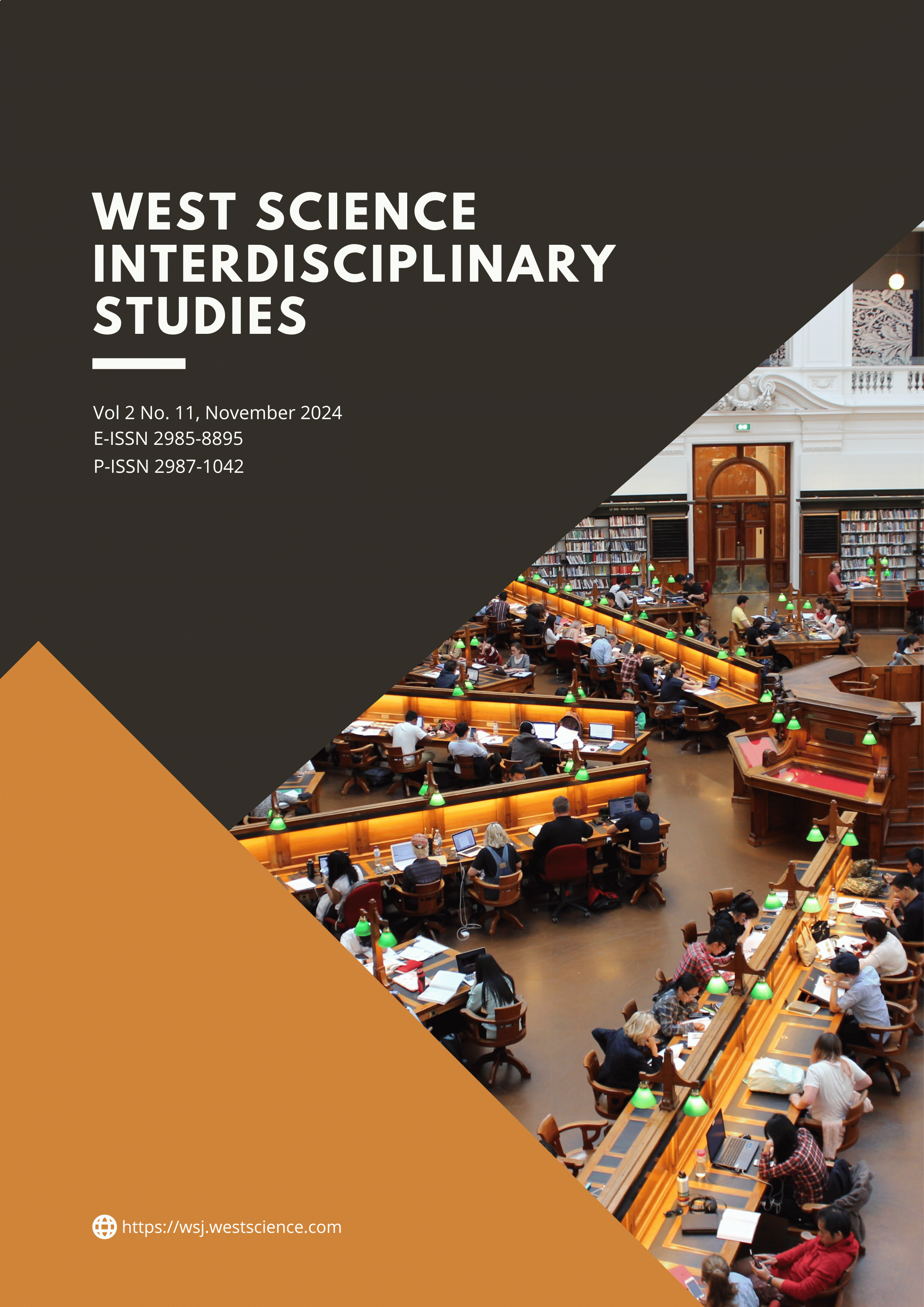Utilization of Solar Energy in Improving Energy Efficiency of Urban Households: A Bibliometric Review
DOI:
https://doi.org/10.58812/wsis.v2i11.1469Keywords:
Solar Energy, Energy Efficiency, Urban Households, Photovoltaic Systems, Smart Grids, Bibliometric AnalysisAbstract
The utilization of solar energy has emerged as a critical solution for improving energy efficiency and achieving sustainability in urban households. This study conducts a bibliometric review to explore the research landscape on solar energy adoption, focusing on technological advancements, socio-economic implications, environmental benefits, and policy frameworks. The analysis identifies key themes such as photovoltaic innovations, smart grid integration, and energy storage technologies, as well as the influence of government incentives and community-based projects on adoption rates. While solar energy offers significant environmental and economic benefits, challenges such as high installation costs, energy variability, and aesthetic concerns remain. The findings highlight the need for interdisciplinary approaches and emerging technologies, including artificial intelligence and decentralized systems, to overcome these barriers. This review provides valuable insights for researchers, policymakers, and stakeholders to advance solar energy utilization and contribute to sustainable urban development.
References
V. Vidović, G. Krajačić, N. Matak, G. Stunjek, and M. Mimica, “Review of the potentials for implementation of floating solar panels on lakes and water reservoirs,” Renew. Sustain. Energy Rev., vol. 178, p. 113237, 2023.
J. Bebbington and J. Unerman, “Achieving the United Nations Sustainable Development Goals: an enabling role for accounting research,” Accounting, Audit. Account. J., vol. 31, no. 1, pp. 2–24, 2018.
A. M. Salim and S. Abu Dabous, “A review of critical success factors for solar home system implementation in public housing,” Int. J. Energy Sect. Manag., vol. 17, no. 2, pp. 352–370, 2023.
M. Alipour, S. G. Zare, F. Taghikhah, and R. Hafezi, “Sociodemographic and individual predictors of residential solar water heater adoption behaviour,” Energy Res. Soc. Sci., vol. 101, p. 103155, 2023.
G.-R. Lee, B.-J. Lim, S.-H. Cho, M. Farooq, and C.-D. Park, “Economic Feasibility Study on an Integrated System of Solar Thermal-Heat Pump for Industrial Process Steam Supply,” J. Korean Sol. Energy Soc., vol. 44, no. 2, pp. 91–104, 2024.
R. Chen, M. Ramzan, M. Hafeez, and S. Ullah, “Green innovation-green growth nexus in BRICS: does financial globalization matter?,” Journal of Innovation & Knowledge. Elsevier, 2023.
P. Hartmann and V. Apaolaza-Ibáñez, “Consumer attitude and purchase intention toward green energy brands: The roles of psychological benefits and environmental concern,” J. Bus. Res., vol. 65, no. 9, pp. 1254–1263, 2012.
P. S. Nigam and A. Singh, “Production of liquid biofuels from renewable resources,” Prog. energy Combust. Sci., vol. 37, no. 1, pp. 52–68, 2011.
J. Vourdoubas, “Solar Electricity Generation from Floating Photovoltaics Installed in Water Dams: A Case Study from the Island of Crete, Greece,” 2023.
H. M. Ross, L. Hosman, B. Baikie, E. Blau, and C. J. Simpson, “SolarSPELL health and education: global solutions with local impacts,” J. Glob. Heal. Reports, vol. 6, p. e2022050, 2022.
B. Solikhah, I. F. S. Wahyuningrum, A. Yulianto, E. Sarwono, and A. K. Widiatami, “Carbon emission report: a review based on environmental performance, company age and corporate governance,” in IOP conference series: earth and environmental science, IOP Publishing, 2021, p. 12042.
D. Viruega Sevilla, A. Francisco López, and P. M. Bello Bugallo, “The Role of a Hazardous Waste Intermediate Management Plant in the Circularity of Products,” Sustain., vol. 14, no. 3, 2022, doi: 10.3390/su14031241.
M. Qamruzzaman, “Nexus between environmental innovation, energy efficiency and environmental sustainability in the lower-income economy,” GSC Adv. Res. Rev., vol. 12, no. 1, pp. 68–83, 2022.
E. Koutroulis, D. Kolokotsa, A. Potirakis, and K. Kalaitzakis, “Methodology for optimal sizing of stand-alone photovoltaic/wind-generator systems using genetic algorithms,” Sol. energy, vol. 80, no. 9, pp. 1072–1088, 2006.
N. Fumo and M. A. R. Biswas, “Regression analysis for prediction of residential energy consumption,” Renew. Sustain. energy Rev., vol. 47, pp. 332–343, 2015.
M. C. Bozchalui, S. A. Hashmi, H. Hassen, C. A. Canizares, and K. Bhattacharya, “Optimal operation of residential energy hubs in smart grids,” IEEE Trans. Smart Grid, vol. 3, no. 4, pp. 1755–1766, 2012.
F. Brahman, M. Honarmand, and S. Jadid, “Optimal electrical and thermal energy management of a residential energy hub, integrating demand response and energy storage system,” Energy Build., vol. 90, pp. 65–75, 2015.
P. D. Dongare et al., “Nanophotonics-enabled solar membrane distillation for off-grid water purification,” Proc. Natl. Acad. Sci., vol. 114, no. 27, pp. 6936–6941, 2017.
R. Scarpa and K. Willis, “Willingness-to-pay for renewable energy: Primary and discretionary choice of British households’ for micro-generation technologies,” Energy Econ., vol. 32, no. 1, pp. 129–136, 2010.
E. Martinot, A. Chaurey, D. Lew, J. R. Moreira, and N. Wamukonya, “Renewable energy markets in developing countries,” Annu. Rev. energy Environ., vol. 27, no. 1, pp. 309–348, 2002.
K. Tang et al., “Temperature-adaptive radiative coating for all-season household thermal regulation,” Science (80-. )., vol. 374, no. 6574, pp. 1504–1509, 2021.
M. Chandrashekara and A. Yadav, “Water desalination system using solar heat: a review,” Renew. Sustain. Energy Rev., vol. 67, pp. 1308–1330, 2017.
W. Gwenzi, N. Chaukura, C. Noubactep, and F. N. D. Mukome, “Biochar-based water treatment systems as a potential low-cost and sustainable technology for clean water provision,” J. Environ. Manage., vol. 197, pp. 732–749, 2017.
K. Sharma and H. P. Mathur, “Contextualizing sustainability with reference to startups,” Prabandhan Indian J. Manag., vol. 15, no. 7, pp. 8–23, 2022.
S. Lodhia, A. Kaur, and S. C. Kuruppu, “The disclosure of sustainable development goals (SDGs) by the top 50 Australian companies: substantive or symbolic legitimation?,” Meditari Account. Res., vol. 31, no. 6, pp. 1578–1605, 2022.
S. Mukhopadhyay and P. Upadhyay, “Institutional intervention in technology innovation: the struggle to increase mobile payment adoption,” Digit. Policy, Regul. Gov., vol. 24, no. 1, pp. 74–92, 2022.
Downloads
Published
Issue
Section
License
Copyright (c) 2024 Farida Arinie Soelistianto, Aris Triwiyatno, Bambang Winardi, Arnes Yuli Vandika

This work is licensed under a Creative Commons Attribution-ShareAlike 4.0 International License.





















 Instagram
Instagram 